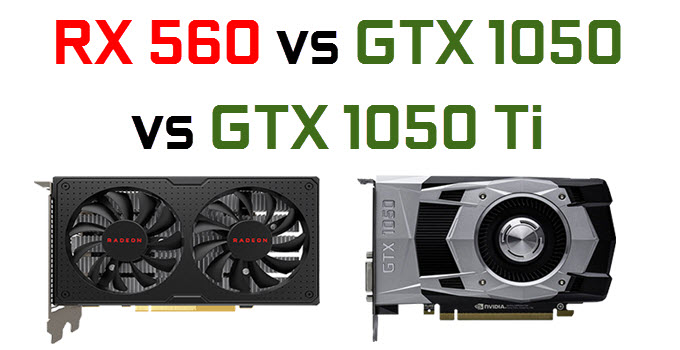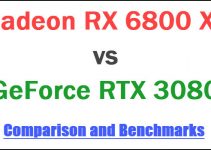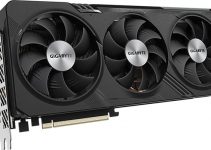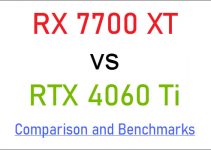Radeon RX 560, GeForce GTX 1050, and GeForce GTX 1050 Ti are budget mid-range graphics cards from AMD and Nvidia. All these are mainstream graphics cards and are the best budget graphics cards for building a budget gaming PC. Radeon RX 560 is a relatively newer card while GeForce GTX 1050 and GeForce GTX 1050 Ti have been around for a while, and are one of the best-selling graphics cards. Here I am going to compare these three graphics cards so that you can decide better, which one to get for your gaming PC according to your budget and other needs.

RX 560 vs GTX 1050 vs GTX 1050 Ti Comparison
Here is a detailed comparison of Radeon RX 560, GeForce GTX 1050, and GeForce GTX 1050 Ti graphics cards based on their specifications, features, performance, and power consumption.
GPU Architecture
Radeon RX 560 is built on the latest Polaris GPU architecture and comes with 1024 Stream Processors. On the other hand, GeForce GTX 1050 and GeForce GTX 1050 Ti are based on the Pascal GPU architecture from Nvidia. GTX 1050 comes with 640 CUDA Cores and GTX 1050 Ti comes with 768 CUDA Cores. Stream Processors and CUDA Cores work on different technologies and cannot be equated, just on their numbers. You can learn about the difference between CUDA Cores and Stream Processors from the link given below.
Must Read: CUDA Cores vs Stream Processors Explained
Memory
Radeon RX 560 comes with 2GB or 4GB GDDR5 memory having 128-bit interface. GTX 1050 comes with 2GB GDDR5 memory and GTX 1050 Ti comes with 4GB GDDR5 memory, both having 128-bit interface. The memory bandwidth offered by all these cards is the same at 112 GB/s.
Check out: HBM vs GDDR5 vs HBM2 vs GDDR5X Comparison
Features
All these three mid-range graphics cards support DirectX 12, OpenGL 4.5 and Vulkan APIs. When it comes to screen tearing preventive technology in games then Radeon RX 560 has FreeSync while GTX 1050 and GTX 1050 Ti has got G-Sync.
Radeon RX 560 does support CrossFire multi-GPU setup while GTX 1050 and GTX 1050 Ti do not support multi-GPU configurations. Also all these GPUs are available for both laptops and desktops.
Check out: Best FreeSync and G-Sync Monitor for Gaming
Gaming Performance
There is no doubt that GeForce GTX 1050 Ti is the fastest of all of these three graphics cards. Radeon RX 560 and Geforce GTX 1050 come second, having almost similar kind of performance in games. In some games, Radeon RX 560 takes the lead in some GeForce GTX 1050 that comes out on the top. The main advantage of the Radeon RX 560 over GTX 1050 is that it comes with higher 4GB memory which can give it a performance gain at higher resolutions and also makes it a bit future-proof. Also in Vulkan and DirectX 12 titles, Radeon RX 500 series graphics cards offer much better performance.
Some Gaming Benchmarks of RX 560, GTX 1050 & GTX 1050 Ti
| Game / Graphics Settings | Radeon RX 560 | GeForce GTX 1050 | GeForce GTX 1050 Ti |
| Mass Effect: Andromeda (1080p, Ultra) | 37 FPS | 46 FPS | 51 FPS |
| DOOM (Vulkan, 1080p, Ultra) | 74 FPS | 44 FPS | 72 FPS |
| AOTS (DX12, 1080p, High) | 33 FPS | 32 FPS | 42 FPS |
| Sniper Elite (DX12, 1080p, High) | 52 FPS | 43 FPS | 55 FPS |
Power Consumption
In terms of power consumption, Nvidia graphics cards are clearly the winner here but by a slight margin only. Radeon RX 560 has a maximum power consumption of 80W and requires a 450W PSU for its working while GeForce GTX 1050 and GeForce GTX 1050 Ti consumes 75W power and requires a 400W PSU for its working. You may find GTX 1050 and GTX 1050 graphics cards without external power but Radeon RX 560 always requires a 6-pin PCI-Express power connector for its working.
Check out: Best Budget Power Supply or PSU for Gaming PC
Price
Radeon RX 560 and GTX 1050 are priced very close to each other but you can get the 2GB version of Radeon RX 560 at a cheaper price compared to GTX 1050. GeForce GTX 1050 Ti is on another level of performance and it costs a bit more than Radeon RX 560 and GeForce GTX 1050. You can check the latest prices of all these graphics cards from the links given below.
Check GeForce GTX 1050 Ti Price
RX 560 vs GTX 1050 vs GTX 1050 Ti Specifications
| Specifications | Radeon RX 560 | GeForce GTX 1050 | GeForce GTX 1050 Ti |
| CUDA Cores / Stream Processors | 1024 | 640 | 768 |
| GPU Architecture | Polaris | Pascal | Pascal |
| Memory Size | 2GB / 4GB GDDR5 | 2GB GDDR5 | 4GB GDDR5 |
| Memory Interface | 128-bit | 128-bit | 128-bit |
| Memory Bandwidth | 112 GB/s | 112 GB/s | 112 GB/s |
| Bus Interface | PCI Express 3.0 | PCI Express 3.0 | PCI Express 3.0 |
| DirectX | 12 | 12 | 12 |
| OpenGL | 4.5 | 4.5 | 4.5 |
| Vulkan API | Yes | Yes | Yes |
| SLI / CrossFire | Yes, Crossfire | No | No |
| VR Ready | No | No | No |
| G-Sync / FreeSync | FreeSync | G-Sync | G-Sync |
| Power Consumption | 80W | 75W | 75W |
| Recommended PSU | 450W | 300W | 300W |
Final Verdict
All these three mid-range graphics cards are great for 1080p gaming and are very affordable. If I have to pick the graphics card that offers great value for money then I would go with Radeon RX 560 because of its higher performance and 4GB memory over the GTX 1050. For pure performance, GTX 1050 Ti is the best card out here and it also consumes less power beating Radeon RX 560, which is slower than it.
My Picks:
Best Value for Money: Radeon RX 560
Best Performance: GeForce GTX 1050 Ti
(*This post may contain affiliate links, which means I may receive a small commission if you choose to purchase through the links I provide (at no extra cost to you). Thank you for supporting the work I put into this site!)



Fantastic post Akshat. I have thoroughly enjoyed reading your posts. The information you disseminate has been very helpful to me in leaning and understanding all the various details concerning graphics cards. Thanks so very much for your posts. I am trying to find a decent priced 1050ti to upgrade and old a10 series acer desktop, have not had much luck in the current market, any thoughts would be helpful. You may want to do a post ( if you haven’t already ) about all the fake 1050ti’s which are out there. Thanks again, Bennett
Thanks for the appreciation. Well, you can look for a used or refurbished GTX 1050 Ti if new ones are hard to find. Here are the posts on how to identify a fake graphics card and a detailed guide on buying a refurbished graphics card.
https://graphicscardhub.com/chinese-fake-graphics-card/
https://graphicscardhub.com/refurbished-graphics-card-guide/